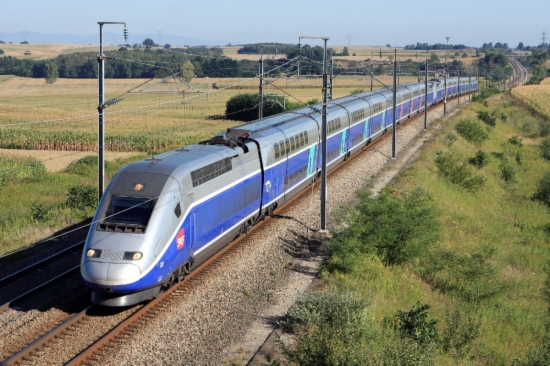The first direct TGV connecting Barcelona and Paris on the 15th of December
The Spanish Government has finally set a date for the first direct High Speed Train between Barcelona and Paris. Passengers will no longer have to switch trains near the French border and a direct TGV will link Paris and Barcelona from the 15th of December. The journey will last 6 hours and 20 minutes, since there is no high-speed railway in the 200-kilometre stretch between Perpignan and Nîmes and trains circulate at a regular speed. The High-Speed railway between Nîmes and Montpellier should be operative by 2017, but the French Government announced last June that the construction of the 150 km between Montpellier and Perpignan would be delayed beyond 2030. The Catalan Executive as well as French and Catalan Euro MPs have requested the French Government to reconsider its decision after the EU has included the Mediterranean Railway Corridor among its 9 main transport priorities until 2020.

Barcelona (ACN).- After many years of delay, the Spanish Government has finally set a date for the first direct High Speed Train between Barcelona and Paris. On Wednesday, the Spanish Transport Minister, Ana Pastor, announced that passengers will no longer have to switch trains near the French border and that a direct TGV will link Paris and Barcelona from the 15th of December. The Spanish train operator Renfe will set two connections per day. Pastor added that the last technical details are being fine tuned but that they are already working with this time deadline. The journey between Barcelona and Paris will last 6 hours and 20 minutes, since there is no high-speed railway in the 200-kilometre stretch between Perpignan and Nîmes and trains circulate at a regular speed. The High-Speed railway between Nîmes and Montpellier should be operative by 2017, but the French Government announced last June that the construction of the 150 km between Montpellier and Perpignan would be delayed beyond 2030. This decision adds an additional travelling hour. The Catalan Executive as well as French and Catalan Euro MPs have requested the French Government to reconsider its decision after the EU has included the Mediterranean Railway Corridor among its 9 main transport priorities until 2020.
Pastor made the announcement in the corridors of the Spanish Parliament, after the Catalan Transport Minister, Santi Vila, had complained that all the technical obstacles had been resolved and that the only missing thing was setting an exact date to start the service. Pastor replied to Vila that “technicians” were currently “finishing” the last steps of the “standardisation process”. She added that, “if everything goes OK, the prevision is that the first commercial train should circulate on the 15th of December”. The official announcement should be made at the next Hispano-French summit, on the 27th of November.
A connection arriving with decades of delay
The High Speed Train connection between Barcelona and Paris was an historical claim, dating back to three decades ago. The first High-Speed Train linking Catalonia and Paris started to circulate on December 2010, although it was not departing from Barcelona but from Figueres, a Catalan city located 30km south from the French border and 120km north from Barcelona. At that time, the Catalan capital was only a final destination on the Madrid-Zaragoza-Lleida-Tarragona-Barcelona line, which was gradually unveiled between 2003 and 2008. In fact, the Spanish Government did not connect Barcelona by High Speed Train until March 2008, many years after scheduled. The Madrid-Seville line was operational since winter 1992. However, Barcelona still had to wait until January 2013 to see a first High-Speed Train heading north and therefore being connected to France. The first High Speed Train connecting Barcelona with Girona and Figueres started to function 10 months ago. In Figueres, passengers were able to switch trains and take a French TGV that was crossing the Pyrenees and going to Paris.
A 200 km bottleneck in France
Despite Wednesday’s positive news, there is still a bottle neck pending to be resolved to link Barcelona and Spain to the European High Speed Train network: the 204 kilometre stretch between Nimes and Perpignan. Between these two cities, trains can only circulate at a maximum speed of 100 km/h, instead 300 km/h, with the ensuring delays. For these reasons, direct trains between Barcelona and Paris will now take 6 hours and 20 minutes. If the entire journey was using High Speed Railway, the travelling time could be reduced to 5 hour or even 4.5h. The French Government has already announced that the 48 km stretch between Nimes and Montpellier will be operational by 2017. However, it also announced last June that it would not build the 156 km stretch between Perpignan and Montpellier, which could reduce travelling time between both cities by 1 hour, before 2030 at least.
European petition to the French Government to build the missing High Speed Railway stretch
On Tuesday, the European Parliament approved to include the Mediterranean Railway Corridor among its Transport Priorities for the 2014-2020 period, which can receive EU funds until 2030. This corridor foresees railway transport for freight and passengers, including High Speed Train. It links Barcelona with the Gibraltar area and Central and Northern Europe. On Wednesday, 11 French and Catalan Members of the European Parliament sent a letter to the French Transport Minister, Frédéric Cuvillier, asking him to reconsider Paris’ decision not to build the High-Speed Railway between Perpignan and Montpellier. The Euro MPs argue that now this project is among the 9 major transport corridors of the European Union, becoming a continental priority.